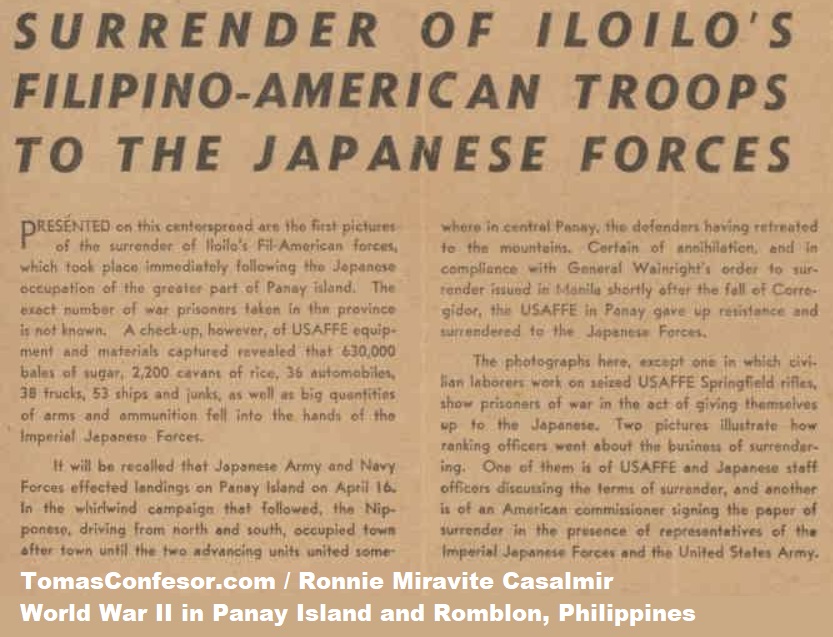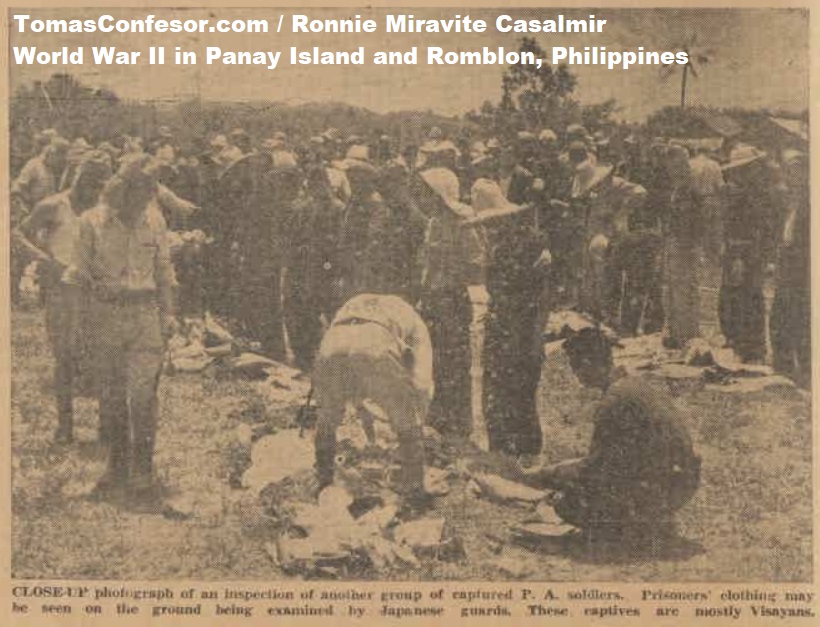 PRESENTED on this centerspread are the first pictures
of the surrender of lloilo's Fil-American forces,
which took place immediately following the Japanese
occupation of the greater part of Panay island. The
exact number of war prisoners taken in the province
is not known. A check-up, however, of USAFFE equipment and materials captured revealed that 630,000
bales of sugar, 2,200 cavans of rice, 36 automobiles,
38 trucks, 53 ships and junks, as well as big quantities
of arms and ammunition fell into the hands of the
Imperial Japanese Forces.
PRESENTED on this centerspread are the first pictures
of the surrender of lloilo's Fil-American forces,
which took place immediately following the Japanese
occupation of the greater part of Panay island. The
exact number of war prisoners taken in the province
is not known. A check-up, however, of USAFFE equipment and materials captured revealed that 630,000
bales of sugar, 2,200 cavans of rice, 36 automobiles,
38 trucks, 53 ships and junks, as well as big quantities
of arms and ammunition fell into the hands of the
Imperial Japanese Forces.
It will be recalled that Japanese Army and Navy Forces effected landings on Panay Island on April 16. In the whirlwind campaign that followed, the Nipponese, driving from north and south, occupied town after town until the two advancing units united somewhere in central Panay, the defenders having retreated to the mountains. Certain of annihilation, and in compliance with General Wainright's order to surrender issued in Manila shortly after the fall of Corregidor, the USAFFE in Panay gave up resistance and surrendered to the Japanese Forces.
The photographs here, except one in which civilian laborers work on seized USAFFE Springfield rifles, show prisoners of war in the act of giving themselves up to the Japanese. Two pictures illustrate how ranking officers went about the business of surrendering. One of them is of USAFFE and Japanese staff officers discussing the terms of surrender, and another is of an American commissioner signing the paper of surrender in the presence of representatives of the Imperial Japanese Forces and the United States Army.
|
May 19, 1945 - Lt. Col. Allan Thayer, staff officer of the USFIP, arrived at Cabatuan Airfield (in Cabatuan, Iloilo) in order to coordinate the surrender of the USAFFE in Panay. May 24, 1945 - Division Commander Christie and 1,800 men surrendered to the Japanese force. May 29, 1945 - A U.S. major surrendered to the Takahashi Company of the Japanese Army at Daja, Maasin. - The Blood and Mud in the Philippines |
|
During the time that the Kawamura Detachment was operating in Panay, the Japanese forces in Luzon had launched a general attack on Corregidor. At Corregidor on May 6, 1942, US Lieutenant General Jonathan Wainwright surrendered all US and Philippine forces that had been resisting the Japanese throughout the Philippine Islands.
Lieutenant Colonel Alan Thayer was a staff officer of the USFIP (US Forces in the Philippines) assigned to the Visayas and Mindanao.13 In the early morning of May 19, he flew to the town of Cabatuan, Iloilo, with Japanese escorts. He relayed the order of surrender issued by Major General Willlam F. Sharp, Commander for Visayas and Mindanao to Colonel Alben Christie of the 61st Division situated at Mt. Baloy. On May 24, 1942, Colonel Christie and other high-ranking officers surrendered to the Japanese Army with about 1,800 soldiers. The remaining 6,000 officers and men either remained in seclusion in the mountains with their weapons or went home to their families. This resulted to the apparent break-up of the military organization in Panay. - The Blood and Mud in the Philippines, Section 1.2 |
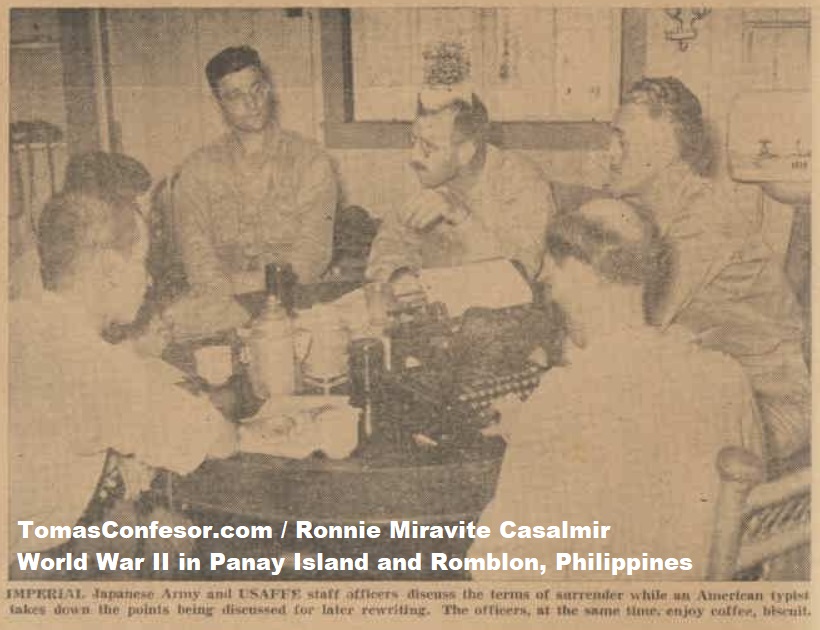
IMPERIAL Japanese Army and USAFFE staff officers discuss the terms of surrender while an American typist takes down the points being discussed for later rewriting. The officers, at the same time, enjoy coffee, biscuit.

A COMMISSIONER of the Fil-Amerlcan forces in Iloilo signs the paper of unconditional surrender. Looking on at his side of the table are two members of the USAFFE staff. At the other side are Japanese staff officers.
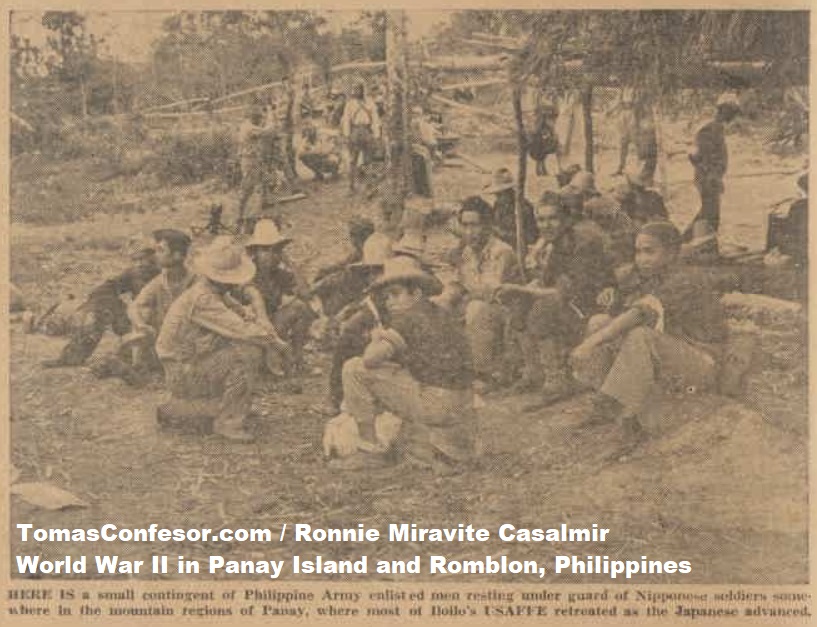
HERE IS a small contingent of Pliilippine Army enlisted men resting under guard of Nipponese soldiers some where in the mountain regions of Panay, where most ot lloilo's USAFFE retreated as the Japanese advanced.

CLOSE-UP photograph of an inspection of another group of captured P. A. soldiers. Prisoners' clothing may be seen on the ground, being examined by Japanese guards. These captives are mostly Visayans.
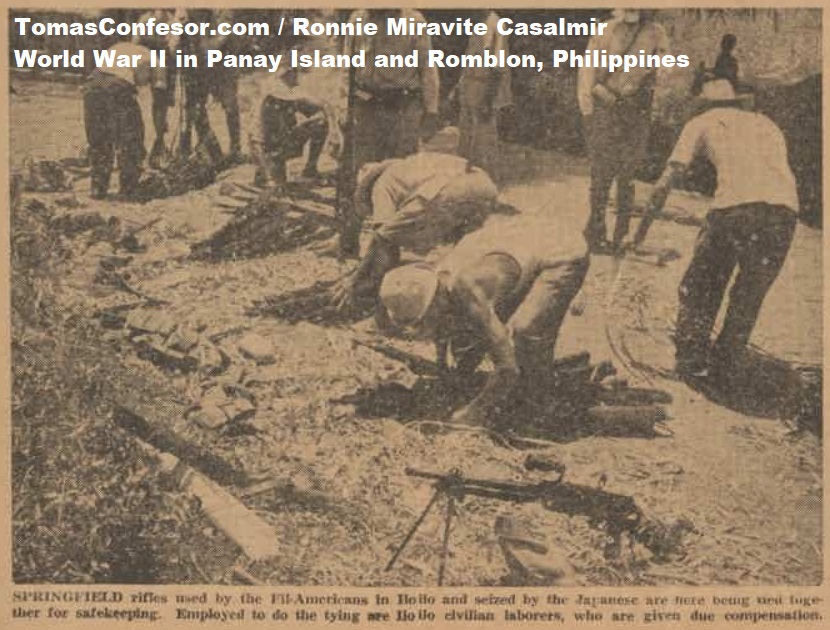
SPRINGFIELD rifles used by the Fil-Americans In Iloilo and seized by the Japanese are here being tied together for safekeeping. Employed to do the tying are Iloilo civilian laborers, who are given due compensation.

AWAITING orders from their captors are these prisoners of war, disarmed and ready to go wherever directed. Developments indicate that their release may depend on peace and order in their provinces.
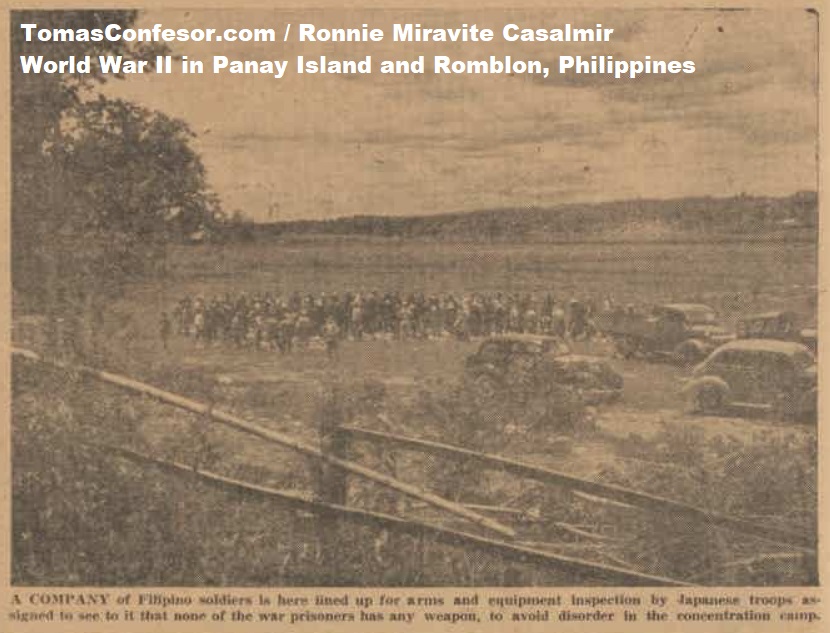
A COMPANY of Filipino soldiers is here lined up for arms and equipment inspection by Japanese troops assigned to see to it that none of the war prisoners has any weapon, to avoid disorder in the concentration camp.

IN THE foreground, facing the camera and flanked by Japanese soldiers, are two Filipino captains (see bars on caps), one a combatant officer and the other a P. A. medical man, as shown by his Red Cross armband.
